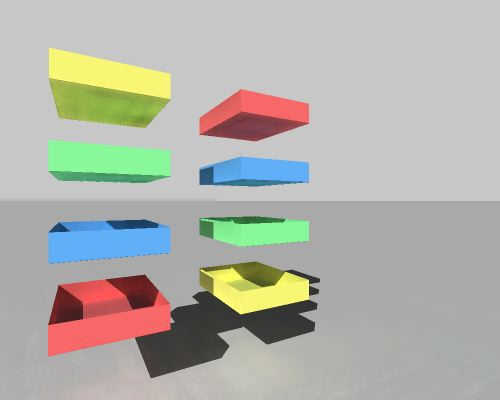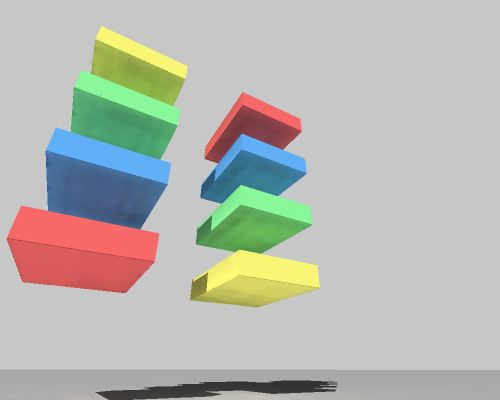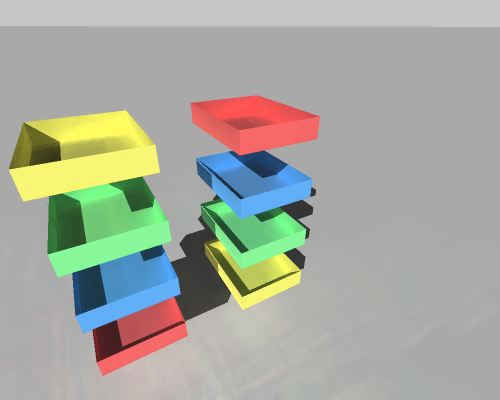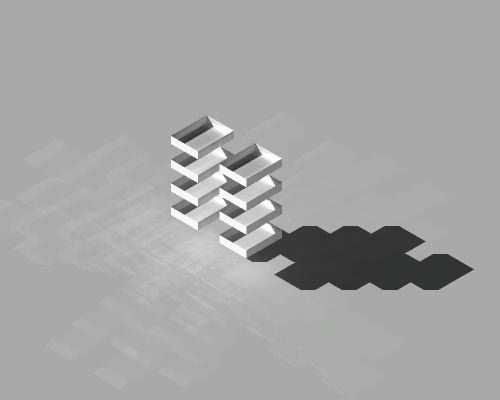 Looking
at these paintings and thinking about all the spatial signifying
going on — i'm struck by those old-timey coded uses and
shorthands of space and volume — and how other that refining
the mechanics of our tools we still don't have any really accurate
way of depicting relational volumetrics on a flat plane than
they did. There's still all this "style" to it —
methods of telegraphing our intention about the locations of
the things in the spaces — signals that depend on our being
good adherents of the consensual spatial reality that we're
educated into.
Looking
at these paintings and thinking about all the spatial signifying
going on — i'm struck by those old-timey coded uses and
shorthands of space and volume — and how other that refining
the mechanics of our tools we still don't have any really accurate
way of depicting relational volumetrics on a flat plane than
they did. There's still all this "style" to it —
methods of telegraphing our intention about the locations of
the things in the spaces — signals that depend on our being
good adherents of the consensual spatial reality that we're
educated into.
 A
place to see how this is still very much with us is if you look
closely at computer perspective rendering engine output.
A
place to see how this is still very much with us is if you look
closely at computer perspective rendering engine output.

[15mm
"lens" - verticals still parallel]
 In
the "camera" views - rather than in the orthographic
panes in which most of us mesh-pullers do our construction (otherwise
you go mad watching stuff scoot off toward the horizon in exponential
acceleration if you move it in a perspective plane) all the
major software players have these signature little tweaks of
how they handle the angular distortion that informs us of the
degree of telephoto or wide angle lens effect we're dealing
with once the camera angle is above or below and angled to either
side of the centerpoint of the rendered area.
In
the "camera" views - rather than in the orthographic
panes in which most of us mesh-pullers do our construction (otherwise
you go mad watching stuff scoot off toward the horizon in exponential
acceleration if you move it in a perspective plane) all the
major software players have these signature little tweaks of
how they handle the angular distortion that informs us of the
degree of telephoto or wide angle lens effect we're dealing
with once the camera angle is above or below and angled to either
side of the centerpoint of the rendered area.

[15mm
— we've gone 3point. Verticals converging and closest masses
getting stretched]
 And
while these distortion tweaks follow internally consistent rules
in any given software, they don't strictly follow the rules
of conventional mechanical perspective — 1, 2, 3 point
multi or what have you — any more than people working backwhen
at the Gothic / Modern perceptual schism did.
And
while these distortion tweaks follow internally consistent rules
in any given software, they don't strictly follow the rules
of conventional mechanical perspective — 1, 2, 3 point
multi or what have you — any more than people working backwhen
at the Gothic / Modern perceptual schism did.
 Many
software algorithms exaggeratedly stretch things "up and
down and out" to gain that spread as you go wide angle,
off center, and above or below the ground plane — i.e.
— 3 point perspective is hard to make look good when we
have all these biases and expectations.
Many
software algorithms exaggeratedly stretch things "up and
down and out" to gain that spread as you go wide angle,
off center, and above or below the ground plane — i.e.
— 3 point perspective is hard to make look good when we
have all these biases and expectations.

[15mm
- again 3pt with verticals converging — all these examples
were spun around the same point in the middle of all the boxes.
In every case, we were -30°Y and ±30°X. The camera
stays at the same distance from the pivot point. . . ]
 You
have to fool around at extreme wide angles with known-shape
objects in wire frame - and be looking for it - before you really
start to see what each software gimmick is ... otherwise you
just accept it without thinking about it.
You
have to fool around at extreme wide angles with known-shape
objects in wire frame - and be looking for it - before you really
start to see what each software gimmick is ... otherwise you
just accept it without thinking about it.
It's weird, we're still really wired like Cro-Magnon rock throwers
and Gothic spearchuckers. The "why" of our eyes being
set apart — the better to kill and eat you factor —
wasn't an evolutionary anticipation of a need to grove on perspective
in painting, and that's one of the reasons this Art Stuff still
works on us. It's a sort of cognitive dissonance that is not
so much purely mental and psychological as it is an argument
between the viscera and the brain. We know what we feel about
it, but it just ain't so.
The
other reason is, of course, that we all still believe the world
out in front of us is flat.

I'm
throwing this one in cuz it feels like inadvertent art to me.




